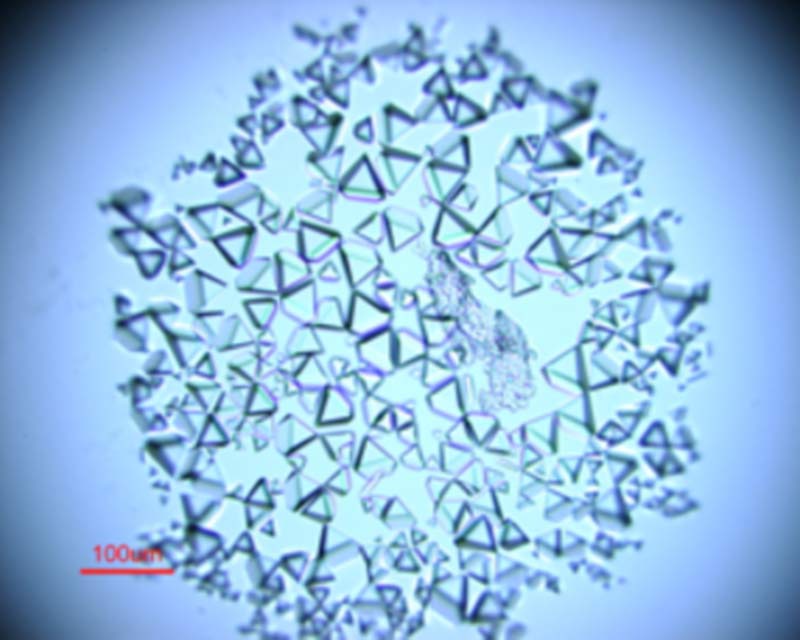Crystallization and crystallography
This PBSIM service offers a state-of-the-art automated infrastructure for the screening of hundreds of crystallization conditions from limited amounts of biological samples, and ensures the follow-up of the results.
This service is equipped with a nano-volume crystallization robot for the screening and optimization of conditions; a liquid-handling robot for the filling of reservoirs with screening kit solutions and the custom design of optimization grids; and two cabinets for storage and visualization of the trays (20°C and 7°C). Crystal quality and optimal cryo-conditions to be employed are assessed using a complete X-ray diffraction equipment. Data collection of full datasets is also possible.
You can find this service in this video: https://www.youtube.com/watch?v=E-5vKfjZoPA&list=PLhk31IqVPY96UXlRAOGLuz_PyGCFnpGDp&index=
New users of the crystallogenesis service can learn how to use the robots via this video: Les robots de cristallisation Vdéf (univ-mrs.fr)
Notice : The most crucial factor is the quality and purity of your protein sample. We strongly recommend that you check the quality of your protein sample before you plan for an experiment.

Accessibility
Academia and industries
Cost
To be defined based on the service requested.
How to apply?
- Complete the proposal from
and check “Marseille” for the “High throughput crystallization” item - Crystallogenesis contact: Véronique Zamboni
- Crystallography contact: Gerlind Sulzenbacher
Specific equipment
Crystallisation
- 1 Mosquito robot (TTP Labtech)
- 1 EVO150 (Tecan)
- 2 RockImager (Formulatrix) cabinets at 20°C and 8°C, equipped with UV modules and the CRIMS software
- 1 incubator at 12-15°C with no vibrations
X-ray equipment
- 1 sealed tube microsource (Primux100, Anton Paar)
- 1 Mar345 detector mounted on a mardtb stage
- 1 cryostat (Oxford cryosystems)
Publications
- Jabafi I, Selisko B, Coutard B, De Palma AM, Neyts J, Egloff MP, Grisel S, Dalle K, Campanacci V, Spinelli S, Cambillau C, Canard B, Gruez A (2007) Improved crystallization of the coxsackievirus B3 RNA-dependent RNA polymerase. Acta Crystallogr. F63, 495-8.
- Vincentelli R, Bignon C, Gruez A, Canaan S, Sulzenbacher G, Tegoni M, Campanacci V, Cambillau C (2003) Medium-scale structural genomics : strategies for protein expression and crystallization. Acc. Chem. Res. 36, 165-72.
- Sulzenbacher G, Gruez A, Roig-Zamboni V, Spinelli S, Valencia C, Pagot F, Vincentelli R, Bignon C, Salomoni A, Grisel S, Maurin D, Huyghe C, Johansson K, Grassick A, Roussel A, Bourne Y, Perrier S, Miallau L, Cantau P, Blanc E, Genevois M, Grossi A, Zenatti A, Campanacci V, Cambillau C (2002) A medium-throughput crystallization approach. Acta Crystallogr. D58, 2109-15.
For more information
For the preliminary screening step, we use a large range of commercial crystallization kits, including some specific kits, in 96-well plates. For each condition, 100-300 nl of protein solution are mixed with 100 nl of a 100-150 µl reservoir solution. Usually, we test 3 different protein concentrations (>3 mg/ml) in varying the volume (100, 200 and 300 nl) of the protein sample. For an initial screening we recommend to assay 2 to 3 different kits. This procedure requires at least 70 µl of protein sample per plate. Various plate types can be provided to users.
For optimization of the initial hits, we have designed a 8×8 grid screen which permits to vary two parameters (e.g., pH value versus precipitant concentration). Each grid requires 10 µl to 48 µl of protein sample for the screening of one or three different protein concentrations. In most cases, several rounds of optimization are required before identification of the best conditions. This step can also be performed manually in 24-well Linbro plates.





